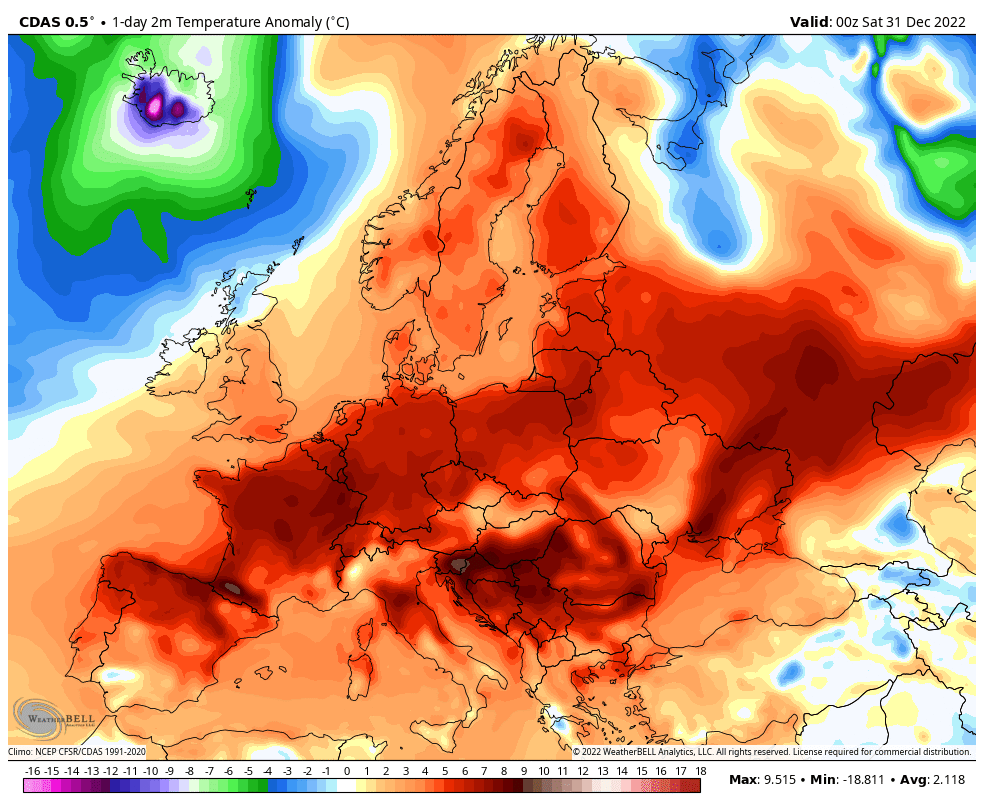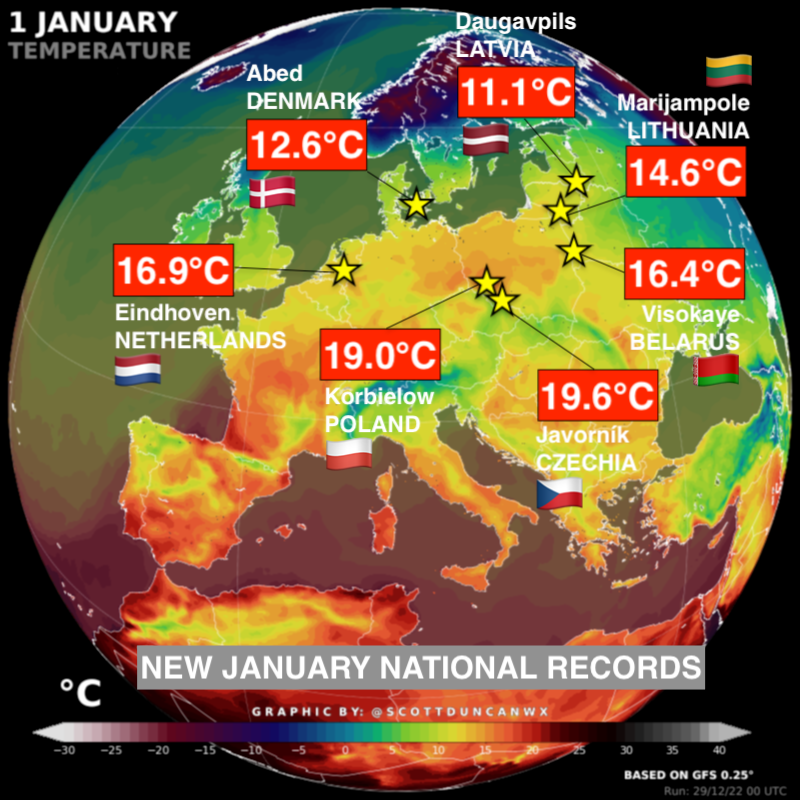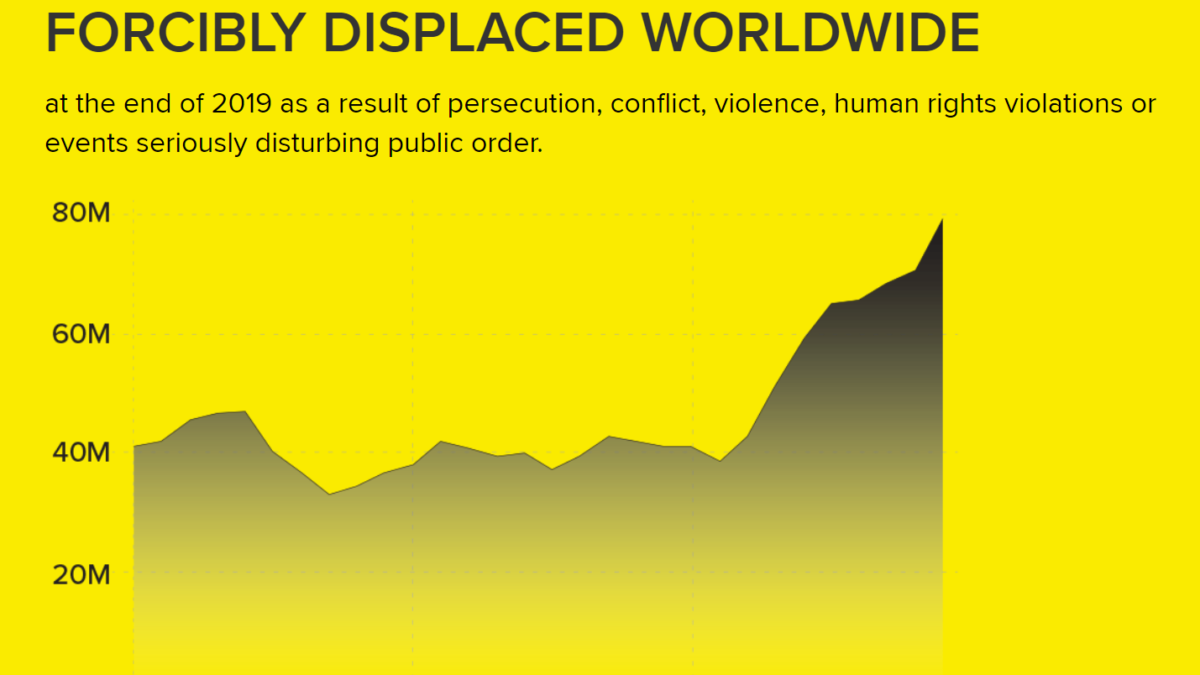Thousands of records shattered in historic winter warm spell in Europe – At least seven countries saw warmest January weather on record on New Year’s Day – “It’s the most extreme event ever seen in European climatology. Nothing stands close to this.”

By Ian Livingston
2 January 2023
(The Washington Post) – As 2022 turned to 2023, an exceptionally strong wintertime heat dome pounced on much of Europe, producing unprecedented warmth for January. As temperatures soared 18 to 36 degrees Fahrenheit (10 to 20 Celsius) above normal from France to western Russia, thousands of records were broken between Saturday and Monday — many by large margins.
The extreme warm spell followed a record-warm year in many parts of Europe and provided yet another example of how human-caused climate change is increasing the frequency and intensity of such extraordinary weather events.
On New Year’s Day, at least seven countries saw their warmest January weather on record as temperatures surged to springtime levels: Latvia hit 52 degrees (11.1 Celsius); Denmark 54.7 degrees (12.6 Celsius); Lithuania 58.3 degrees (14.6 Celsius); Belarus 61.5 degrees (16.4 Celsius); the Netherlands 62.4 degrees (16.9 Celsius); Poland 66.2 degrees (19.0 Celsius); and the Czech Republic 67.3 degrees (19.6 Celsius).
Those who track worldwide weather records described the warm spell as historic and could hardly believe its scope and magnitude.
Maximiliano Herrera, a climatologist who tracks global weather extremes, called the event “totally insane” and “absolute madness” in text messages to the Capital Weather Gang. He wrote that some of the high nighttime temperatures observed were uncommon in midsummer.
It’s “the most extreme event ever seen in European climatology,” Herrera wrote. “Nothing stands close to this.”
Guillaume Séchet, a broadcast meteorologist in France, agreed, tweeting that Sunday was one of the most incredible days in Europe’s climate history.
“The intensity and extent of warmth in Europe right now is hard to comprehend,” tweeted Scott Duncan, a meteorologist based in London.
Here are some of the most impressive records that were set in Europe on New Year’s Day:
- In Poland, it was so warm that the January national high-temperature record was broken before sunrise. The town of Glucholazy was 65.7 degrees at 4 a.m., which is warmer than its average low temperature in midsummer. Temperatures rose further as the day progressed.
- Bilbao, Spain, reached 77.2 degrees (25.1 Celsius), its hottest January day.
- Trois-Ville, France, reached 76.8 degrees (24.9 Celsius), a record for the month. It was among more than 100 records set across the country Sunday, including 75.2 degrees (24.0 Celsius) in Dax, and 65.5 degrees (18.6 Celsius) at stations with data dating to the 1800s in Besançon and Châteauroux.
- Ohlsbach, Germany, reached 66.9 degrees (19.4 Celsius) for a monthly record and the highest temperature of the day in Germany. Other locations, including Berlin at 60.8 degrees (16 Celsius), also set January records. Berlin was among the places that set records both New Year’s Eve and New Year’s Day.
- Warsaw’s high of 66.2 degrees (19 Celsius) demolished the its previous January record by 9.2 degrees (5.1 Celsius).
While the most extreme temperatures occurred on New Year’s Day, exceptionally mild weather began on New Year’s Eve.
Scores of calendar day and monthly records fell on Saturday, surpassing marks set just a year before in many instances. [more]
Thousands of records shattered in historic winter warm spell in Europe



